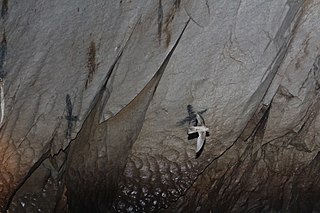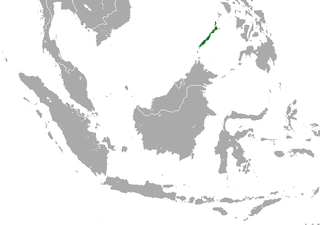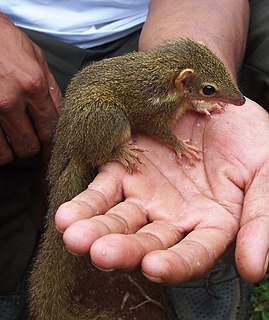
The green imperial pigeon is a large forest pigeon. The large range extends from Nepal, southern India and Sri Lanka eastwards to southern China, Indonesia and the Philippines.
Podocarpus palawanensis is a species of conifer in the family Podocarpaceae. It is found only in the Philippines.

The Palawan swiftlet is a species of swift in the family Apodidae. Some taxonomists consider it to be a subspecies of the uniform swiftlet. It is endemic to the Philippines. It uses echolocation to navigate and hunt in the darkness.

The sulphur-bellied bulbul is a songbird species in the bulbul family, Pycnonotidae. It is endemic to Palawan (Philippines). Its natural habitat is subtropical or tropical moist lowland forests. It is not considered a threatened species by the IUCN.

The yellow-throated leafbird is a species of bird in the family Chloropseidae. It is endemic to the Palawan in the Philippines.

The Palawan treeshrew is a treeshrew species endemic to the Palawan Island, Philippines, where it occurs from sea level to an elevation of 1,400 m (4,600 ft). The population is considered steady.

The Palawan shrew is a species of mammal in the family Soricidae. It is endemic to the Philippines and known from Palawan and Balabac Islands, from sea level to 1,300 m (4,300 ft) asl. It occurs in old growth and scrubby secondary forest. Habitat loss (deforestation) is a potential threat to this little known species, although it seems to tolerate habitat loss and modification.
Orophea palawanensis is a species of plant in the Annonaceae family. It is endemic to the Philippines.
Schefflera palawanensis is a species of plant in the family Araliaceae. It is endemic to the Philippines. It is threatened by habitat loss.

Nepenthes attenboroughii, or Attenborough's pitcher plant, is a montane species of carnivorous pitcher plant of the genus Nepenthes. It is named after the celebrated broadcaster and naturalist Sir David Attenborough, who is a keen enthusiast of the genus. The species is characterised by its large and distinctive bell-shaped lower and upper pitchers and narrow, upright lid. The type specimen of N. attenboroughii was collected on the summit of Mount Victoria, an ultramafic mountain in central Palawan, the Philippines.

The Tupaiidae are one of two families of treeshrews, the other family being Ptilocercidae. The family contains three genera and 19 species. The family name derives from tupai, the Malay word for treeshrew and also for squirrel which the Tupaiidae superficially resemble. The former genus Urogale was disbanded in 2011 when the Mindanao treeshrew was moved to Tupaia based on a molecular phylogeny.

Nepenthes palawanensis is a tropical pitcher plant endemic to Sultan Peak on the island of Palawan in the Philippines, where it grows at elevations of 1100–1236 m above sea level. It was discovered in February 2010 by Jehson Cervancia and Stewart McPherson.

Huberantha korinti is a species of plant in the Annonaceae family. It is native to South Asia.

Huberantha cerasoides is a species of trees in the family Annonaceae and tribe Miliuseae. It is the type species of the relatively new genus Huberantha.

Gekko palawanensis, also known as the Palawan gecko or the Palawan narrow-disked gecko, is a species of gecko. It is endemic to Palawan in the Philippines.

Luperosaurus palawanensis, also known as Palawan wolf gecko or Palawan flapped-legged gecko, is a species of gecko. It is endemic to Palawan in the Philippines.

Huberantha is a genus of plants in the family Annonaceae and tribe Miliuseae. It is distributed in Australia, tropical Asia, East Africa and some Pacific islands. Tanawat Chaowasku named the genus "Huber's flowers" in honor of the German botanist Herbert Huber and to highlight its flowers as a distinguishing feature of the genus. A number of species have been moved here from the genus Polyalthia.

Parvoscincus palawanensis is a species of skink found in the Philippines.
Polyalthiopsis is an Asian tree genus in the family Annonaceae and tribe Miliuseae. Its native range is southern Vietnam.
Draco palawanensis is a species of agamid lizard. It is found in the Philippines.














